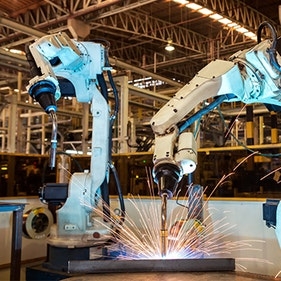This article also appeared on Automotive World on September 17, 2018.
The shift from gasoline to electricity could blow fuses throughout the vehicle powertrain world. Known as the “e-shift,” the transition from conventional internal-combustion engines (ICEs) to battery-driven electric motors will produce significant new quality and reliability challenges for the automotive industry.
Without question, the e-shift will fundamentally change the supplier ecosystem, but automaker powertrain departments themselves will be entering unknown territory. Where in the past both groups relied on experience-based capabilities to deal with ICE issues, now, they must understand new functional interdependencies during the early stages of product development processes. (See Exhibit 1.)
Exhibit 1: Global Ramp‑Up Scenario For Alternative Powertrain Technologies
Production volume in million units (% share of total)
BATTERIES WILL SPARK MAJOR CHANGES
Automakers traditionally produce major ICE elements internally; with electric vehicles (EVs), the battery represents the most expensive part of the drivetrain. However, only a limited group of specialized suppliers, often located across the globe (in China, for instance), currently produce them (although recent developments suggest an emerging willingness to relocate closer to Western customers). A second hurdle involves the different business cultures and competitive behaviors of EV battery suppliers and automakers. Such differences may cause delays and trigger reliability and quality problems.
Research suggests that most recurring technical problems result from product development weaknesses, which in turn stem from a lack of experience in the integration, testing, and validation stages. Likewise, problems associated with product launch, production, or vehicle operation often relate to an incomplete understanding of the technical aspects of a product or system.
While few outsiders understand ICEs as well as industry incumbents, most automakers lack the expertise to optimize EV technologies in the automotive environment.
Take temperature management, for example. The automotive industry has perfected the archetype for ICE temperature management over the past 130 years, which typically includes a radiator, thermostat, engine coolant jacket, pump, and so on. The technologies involved are known commodities; car engineers and technicians know how to design, develop, and produce them for specific engine and drivetrain configurations. With EVs, the battery requires the most attention, and overheating occurs due to the way it interacts with the rest of the powertrain and other parts of the car. Consequently, battery suppliers often cannot remedy overheating problems before automakers install the batteries in specific cars and observe them operating with the rest of the vehicle. At the same time, automakers cannot work on overheating problems before they mate the battery with the vehicle. At this point, optimal temperature management solutions could require a battery redesign along with changes regarding how it integrates with the rest of the powertrain (and vehicle). EV packaging and integration priorities will differ as well, requiring automakers to rethink the entire powertrain system. One EV maker adopted an integrated electronics architecture, for example, dramatically reducing the number of microprocessors it required.
The entire process of mating battery to car to prevent overheating depends on a comprehensive functional analysis. This approach focuses on functions and overcomes system limitations by assessing the machines’ building blocks and executing a risk assessment (for example, an enhanced form of failure mode effects analysis, or FMEA). Based on the outlined risks, engineers can design and execute targeted verification tests.
Vehicle crash-worthiness is another area prime for functional analysis. The status quo is the result of decades of testing and the analysis of millions of accidents involving ICE-powered cars. EVs, with massive batteries and small electric motors, will require engineers to rethink the entire crash paradigm, from crumple zones to areas requiring reinforcement via high-strength steel.
More than 60% of all vehicles will be electrified by 2030 (but with large regional differences in market penetration).
THE E-SHIFT REQUIRES NEW WAYS OF WORKING WITH SUPPLIERS
Ensuring the functional behavior of a powertrain system requires that engineers understand and model cause-and-effect relationships within an EV’s system. Many times, interactions among sub-functions or parameters will affect the main function, which is why the physical behavior of a system and the interactions between measurable sub-functions drive Oliver Wyman’s functional approach, not hardware components.
Automakers (or their suppliers) may fail to understand the interactions that occur in new powertrain technologies due to torque, temperature, power, or vibration issues. To identify and fix such problems effectively, automakers need know-how and experience. Involving suppliers early in the powertrain product development process can help prevent quality, reliability, and NVH (noise, vibration, and harshness) problems before they impact customer satisfaction. For instance, lacking the covering noise and vibration of an ICE, EVs can emit a host of sounds that engineers struggle to manage.
Consequently, this approach requires much stronger and deeper functional-level collaboration between EV makers and their technology suppliers, as they establish tailored processes. That means much earlier involvement of suppliers in quality issues through the creation of fast response and process improvement approaches. It also requires stronger functional behavior analysis on reliability and risk reduction in the product development process.
At the same time, demand for predictive and transparent tools and methods will increase, as these can identify and control the risks associated with powertrain systems and components in the early development phases. These techniques will prevent critical failures from occurring later in the field, with the end customer.
Some of these collaborative links between automakers and suppliers already exist. For example, many suppliers now operate on or in very close proximity to automaker sites and may assume the role of “resident engineers.” Expanding and reinforcing these links can support the improved processes and relationships needed, thus enabling the more effective exchange of data between automakers and suppliers regarding engineering change orders or supplier shifts. Likewise, the use of combined automaker and supplier teams can promote more robust functional requirements and specifications resulting in fewer recalls, quality defects, and reliability issues down the road. Some companies are already making headway in this area: one Chinese battery producer for a European premium automaker is building a plant in Europe to be closer to its customer.
GEARING UP FOR E-SHIFT
Most automakers have dabbled in EVs, but may be unprepared for the challenges associated with shifting major parts of their product portfolios to these powertrain technologies. By adopting a functional approach to the issue, and by collaborating more closely with key suppliers, automakers can position themselves to make the e-shift seamlessly.







